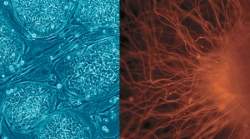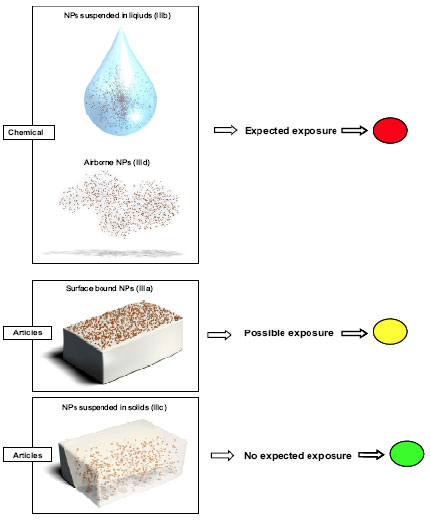 |
| Os pesquisadores usam nanopartículas contendo óxido de ferro, que permitem a visualização das células às quais elas estão anexadas por meio de um técnica de imageamento magnético, uma imagem que "enxerga" apenas o magnetismo nos tecidos. [Imagem: Wikimedia] |
Células-tronco com nanopartículas
Quase todos os dias temos notícias sobre avanços em pesquisas com células-tronco em processos de regeneração de tecidos.
Contudo, apesar dos muitos progressos obtidos, algumas questões sobre o funcionamento destas células permanecem em aberto.
"Que elas funcionam nós sabemos que funcionam, mas nós queremos saber exatamente como," declara o professor Said Rabbani, do Instituto de Física (IF) da USP.
Procurando esclarecer estas dúvidas, Rabbani e seus colegas estão utilizando a marcação de células-tronco com nanopartículas supermagnéticas para realizar imagens celulares.
Nanopartículas são partículas com dimensões medidas na faixa dos nanômetros - 1 nanômetro equivale a 1 bilionésimo de metro.
Nanopartículas magnéticas
Juntando as nanopartículas às células, é possível estudar de forma muito precisa o mecanismo de funcionamento das células, acompanhando o caminho delas antes, durante e após a regeneração.
Os pesquisadores usam nanopartículas contendo óxido de ferro, que permitem a visualização das células às quais elas estão anexadas por meio de um técnica de imageamento magnético, uma imagem que "enxerga" apenas o magnetismo nos tecidos.
Verificando seu destino após terem atuado na regeneração, a marcação pode auxiliar, também, na verificação de possíveis efeitos colaterais da terapia com células-tronco.
Rastreamento de células-tronco
O rastreamento das células marcadas pelas nanopartículas é feito usando como cobaia um porco vivo.
O animal não precisa ser sacrificado, mas é-lhe induzido um infarto do miocárdio.
A seguir, os pesquisadores acompanham a regeneração do coração do animal por meio de ressonância magnética.
O primeiro objetivo da pesquisa, a visualização celular do processo, já foi alcançado.
"O próximo passo será ver para onde as células-tronco vão [após a regeneração], para tentar entender melhor seu mecanismo," diz o pesquisador.
Após o término dos estudos com os porcos, as pesquisas serão feitas com ratos, utilizando-se as nanopartículas acopladas às células-tronco para estudar o trajeto delas em casos de regeneração renal.
A ideia é verificar se o processo ocorre de forma semelhante em diferentes tipos de tecido.
Conhecimento sobre células-tronco
Said afirma que um entendimento mais completo do funcionamento das células-tronco é fundamental para que elas possam ser usadas de forma mais ampla.
O professor conta que, no início das pesquisas, por exemplo, acreditava-se que apenas as células tronco embrionárias teriam as propriedades de regeneração.
Atualmente sabe-se que as células adultas também possuem tais propriedades.
Outra questão levantada pelo professor era o desconhecimento das funções das células-tronco: "Hoje sabe-se que elas não são apenas curingas. Elas também funcionam como um sinalizador".
Isso significa que elas mostram ao corpo quando e onde o trabalho deve ser iniciado e finalizado, como por exemplo na regeneração de um corte realizado na mão.
Esta função poderia ser utilizada para realizar uma liberação mais precisa de medicações que necessitam atuar de forma direta em determinados tecidos, como no caso de um câncer.
"Pode-se encapsular o medicamento juntamente com as células-tronco e então ele atacaria diretamente o tumor, sem ser danoso aos demais tecidos", prevê.
O professor ressalta, porém, que no caso de seu trabalho, não se busca desenvolver métodos de tratamento.
"Nós apenas estudamos o comportamento das células-tronco. Mas nossa pesquisa poderá ser usada por outras áreas para gerar novas formas de diagnóstico ou terapia", conclui.
Fonte: Diário da Saúde


